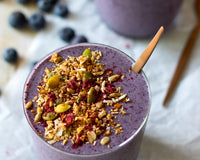The Amino Acid Balance!

During the past few million years, our ancestors were hunters and/or gatherers. At the time, when they were hunting animals for food, they were eating them completely. Meaning, they were eating their meat, bones, muscles and organs. They ate it all! It is important to remember that today’s meat is very different from theirs because it is processed, with traces of hormones and antibiotics, or even, derived from genetically modified (GM) soybeans and corns. Because of food evolution, let’s define our meat, either like "organic" or "grass-fed". This is a real problem because the cells of our body have changed through time and were able to be responsive to changes; they now expect to receive these modified substances. This said, our environment is significantly affected by this curse.
Meat from muscles is high in tryptophan and methionine, but very low in glycine (these are the amino acids). For the organs and bones, it is quite the opposite because they are high in glycine and low in methionine. A diet rich in muscles will result an imbalance between methionine and glycine and will create a strong demand for some important B-vitamins and mineral.
Methionine is the precursor for homocysteine which is a very important protein; although when it builds up and cannot be recycled, it can cause inflammation and can be a major risk factor for heart diseases.
The glycine – low levels in muscles – has important functions, such as in the phase 2 of the hepatic metabolism and in the functioning of the nervous system (it helps reduce anxiety, irritability and insomnia).
When tryptophan is too high and glycine is too low, this can raise serotonin to abnormal levels. In fact, in some cases, it can lead to fatigue and cardiac arrhythmia.
Organs are the most nutrient-rich foods and are a great complement to leafy vegetables, in order to improve the nutritional value of meals. Simply by adding bone broth, chicken hearts and veal livers to your diet, you can achieve a better balance between methionine, tryptophan and glycine levels, since some vegetables are low-nutrient foods or absorb nutrients. Of course, this includes vitamin B-12 and iron, but also vitamin A, zinc, CoQ10, vitamin D, selenium, omega-3 and much more.
This said, once or twice a week, add bone broth and organs to your diet. Take your whey protein after workout and beef protein during your other meals.
I am predicting that we may go back to the hunter and gatherer age! ;)
Sources: https://www.ncbi.nlm.nih.gov/pubmed/573061 https://www.ncbi.nlm.nih.gov/pubmed/16441938 https://www.ncbi.nlm.nih.gov/pubmed/21139123 https://www.ncbi.nlm.nih.gov/pubmed/1685581 https://www.ncbi.nlm.nih.gov/pmc/articles/PMC4353476/ http://www.jbc.org/content/193/1/23.full.pdf https://www.ncbi.nlm.nih.gov/pubmed/25533534 https://www.ncbi.nlm.nih.gov/pubmed/12589194 https://www.ncbi.nlm.nih.gov/pubmed/11176224
Meat from muscles is high in tryptophan and methionine, but very low in glycine (these are the amino acids). For the organs and bones, it is quite the opposite because they are high in glycine and low in methionine. A diet rich in muscles will result an imbalance between methionine and glycine and will create a strong demand for some important B-vitamins and mineral.
Consequences
High levels of methionine and tryptophan can cause vitamin deficiencies, such as B6, B2, B9, B12 and zinc. Some of these elements play an essential role in methylation and hepatic metabolism, as well as in energy, hormones and neurotransmitters production.Methionine is the precursor for homocysteine which is a very important protein; although when it builds up and cannot be recycled, it can cause inflammation and can be a major risk factor for heart diseases.
The glycine – low levels in muscles – has important functions, such as in the phase 2 of the hepatic metabolism and in the functioning of the nervous system (it helps reduce anxiety, irritability and insomnia).
When tryptophan is too high and glycine is too low, this can raise serotonin to abnormal levels. In fact, in some cases, it can lead to fatigue and cardiac arrhythmia.
Organs are the most nutrient-rich foods and are a great complement to leafy vegetables, in order to improve the nutritional value of meals. Simply by adding bone broth, chicken hearts and veal livers to your diet, you can achieve a better balance between methionine, tryptophan and glycine levels, since some vegetables are low-nutrient foods or absorb nutrients. Of course, this includes vitamin B-12 and iron, but also vitamin A, zinc, CoQ10, vitamin D, selenium, omega-3 and much more.
Do not forget!
It is important to make the right choice about the quality selection of our proteins. I noticed that many athletes eat whey proteins for breakfast or as a snack – this leads to high levels of glucose in the blood and amino acid imbalance. My recommendation: buy organic whey proteins that come from grass-fed cows. Eat them only post workout! For breakfast and snacks, opt for hydrolyzed beef protein rich in glycine.This said, once or twice a week, add bone broth and organs to your diet. Take your whey protein after workout and beef protein during your other meals.
I am predicting that we may go back to the hunter and gatherer age! ;)
Sources: https://www.ncbi.nlm.nih.gov/pubmed/573061 https://www.ncbi.nlm.nih.gov/pubmed/16441938 https://www.ncbi.nlm.nih.gov/pubmed/21139123 https://www.ncbi.nlm.nih.gov/pubmed/1685581 https://www.ncbi.nlm.nih.gov/pmc/articles/PMC4353476/ http://www.jbc.org/content/193/1/23.full.pdf https://www.ncbi.nlm.nih.gov/pubmed/25533534 https://www.ncbi.nlm.nih.gov/pubmed/12589194 https://www.ncbi.nlm.nih.gov/pubmed/11176224





